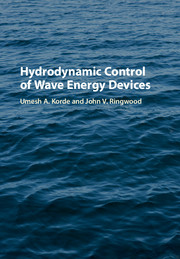Book contents
- Frontmatter
- Contents
- Preface
- Acknowledgments
- Part I Introduction
- Part II The Basics
- Part III The Hydrodynamics
- Part IV Velocity Control Using a Hydrodynamic Model
- Part V Control by Optimizing a Performance Index
- 9 Nonreactive Switching Control
- 10 Optimal Numerical Control of Wave Energy Converters
- 11 Control Strategies for WEC Arrays
- 12 Wave Forecasting for Control
- Part VI Toward Overall WEC System Hydrodynamic Optimization
- Part VII In Closing
- References
- Index
9 - Nonreactive Switching Control
from Part V - Control by Optimizing a Performance Index
Published online by Cambridge University Press: 05 September 2016
- Frontmatter
- Contents
- Preface
- Acknowledgments
- Part I Introduction
- Part II The Basics
- Part III The Hydrodynamics
- Part IV Velocity Control Using a Hydrodynamic Model
- Part V Control by Optimizing a Performance Index
- 9 Nonreactive Switching Control
- 10 Optimal Numerical Control of Wave Energy Converters
- 11 Control Strategies for WEC Arrays
- 12 Wave Forecasting for Control
- Part VI Toward Overall WEC System Hydrodynamic Optimization
- Part VII In Closing
- References
- Index
Summary
Switching control has existed for many years in controls practice and has frequently been a manifestation of “bang-bang” control, where the state of the system is controlled by switching on the full value of the control input in between periods where no control input at all is applied. The origins of this approach in wave energy conversion can be traced back to early studies on small heaving point absorber buoys with short natural resonant periods. The technique consisted of locking the buoy displacement until the approach of a crest (or a trough) and releasing it so it achieved full velocity at the crest (or trough), and then relocking the displacement until the approach of a trough or crest. The presence or absence of a full-valued braking force was thus the only control required. An independent early application of this approach was recorded in the United States by Dedger Jones in the 1970s [139], while by the late 1970s it was already being vigorously developed by Budal and Falnes in Norway and by other workers elsewhere. A formal theoretical foundation was established in the mid-1980s by the work of Nichols and Hoskin [140]. In this chapter we examine the general theory of switching control for enhancing power absorption and, by means of an example of a body oscillating in air, understand why prediction of the future input is required in order to evaluate the optimal switching sequence. The theory is then applied to “latching” of wave energy converters (WECs).
Latching and Declutching
Because the control input can take only two values (on or off; 1 or 0, etc.) for any type of input forcing, latching is an example of nonlinear control. The other way in which it differs from the complex conjugate–type implementations in frequency or time domain is that no reactive control is possible when only braking forces are alternately switched on and off. Consequently, because optimum velocity as defined in Chapter 6 requires reactive loads off resonance, it generally cannot be achieved with latching. Latching control is thus suboptimal in the hydrodynamic control sense, as it does not generally lead to hydrodynamically optimum velocities.
- Type
- Chapter
- Information
- Hydrodynamic Control of Wave Energy Devices , pp. 205 - 219Publisher: Cambridge University PressPrint publication year: 2016



